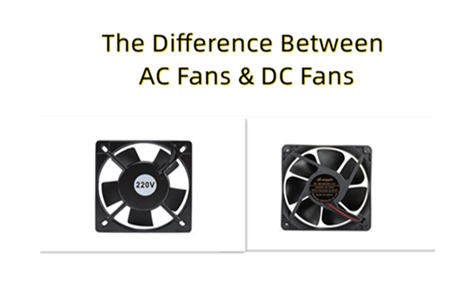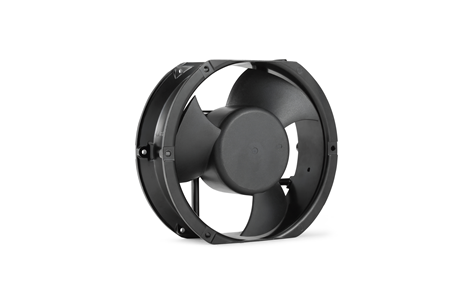The Difference Between AC Fans & DC Fans
- Home>>News>>Company NewsThe Difference Between AC Fans & DC Fans
The Difference Between AC Fans & DC Fans
The direct current fans, or DC fans, are powered with a potential of fixed value such as the voltage of a battery. Typical voltage values for DC fans are, 5V, 12V, 24V and 48V.
In contrast, the alternating current fans, or AC fans, are powered with a changing voltage of positive and of equal negative value. In general, this changing voltage has sinusoidal shape. Worldwide, the usual value of this sinusoidal voltage may vary in size and in frequency, such as 100VAC, 120VAC, 200VAC, 220VAC, 230VAC or 240VAC, and with frequency (cycles per second) of 50Hz or 60Hz.
In the past, big AC fans were typically less expensive compared to big DC fans. Today however, their price difference is negligible due to their payback advantage. We will try to point out differences between the above fan types, to help you choose and purchase the correct fan type for your application.

The Pros and Cons of DC fans

DC technology has become much more sophisticated in recent years, and it can now be applied to both residential and industrial ceiling fans. DC fans have motors that rely on permanent magnets in order to attract and repel a rotor around the axis using electronic switching. DC technology is much newer than AC technology, which means there are fewer options available.
PRO: Consumes less power
DC fans are widely regarded as the most efficient type of fans. They consume significantly less power than AC fans. In fact, DC fans consume up to 70 percent less energy to produce the same output as traditional AC fan types.
This means, that a 25-watt DC-driven yields the same results as 100-watt AC fan. This is ideal for commercial settings, like restaurants, allowing you to keep fans running all day without incurring astronomical electric bills.
PRO: Minimal electromagnetic interference
Due to low power used as well as the application of sophisticated electronic switching, the electromagnetic interference of DC fans is minimal. Sensitive electronic devices often use DC fans to prevent electromagnetic interference.
For example, computer applications and equipment rely on DC fans, to prevent overheating while still minimizing electromagnetic interference that could negatively affect sensitive applications.
PRO: Acoustically Quieter
DC fans make use of a new type (sin180) of electronically commutated motor (ECM). Not only are these motors ultra-efficient, they are also incredibly quiet. Because they are so quiet, DC fans are an excellent option for applications such as medical instruments, telecom switches, or car entertainment systems, where noise could be a nuisance.
PRO: Lower voltage
DC fans generally use less voltage than AC fans. The majority of DC fans are low-voltage fans. For example, you can typically find 5V, 12V, and 24V versions of DC fans. Larger models of DC fans, such as 119mm to 172mm fan models, are typically available in 48V. In comparison, most AC cooling fan models are available in 115V, a much higher voltage. Lower voltage also makes DC fans potentially less dangerous.
PRO: Water-Resistant
The DC fans can be used in applications of severe environmental conditions. It is imperative to employ a reliable, high-quality water-resistant model to ensure the safety of your equipment and staff.
Less expensive “Capacitor” speed control methods, influence the power factor of the fan. Finally, economical “Phase Control” speed control methods introduce electromagnetic noise.
CON: More energy consumption
AC fans do consume more energy than DC fans. You need up to $3 worth of electricity using a DC Fan and you need $10 worth using an AC Fan to achieve the same airflow result.
CON: More electromagnetic interference
AC fans have more electromagnetic interference than DC fans, when they use “Phase Control” speed control methods.
- Max air flow fans
- Machine cooling fan
- Bitcoin digger fan
- Telecome fan
- Stage lamp fan
- Power cooling fan
- Laser module fan
- Min air flow fans
- 3D printer fan
- Amplifier fan
- Computer fan
- Inverter fan
- Charging pile fan
- Car LED lamp fan
Contact
Black@ruiapple.com
TEL:+86 13189756968
FAX:+86 755 88852020
Shenzhen Office: 508#,Tianhe biulding, Baoan Road,Shenzhen,China Factory add: 471#, West Wenwu Road, Economic and Technological Zone, Mianyang City, Sichuan Province, China
Copyright © 2019 SHENZHEN RUIAPPLE ELECTRONICS CO.,LTD Official Record No:粤ICP备19010273号
Support:RUIAPPLE










